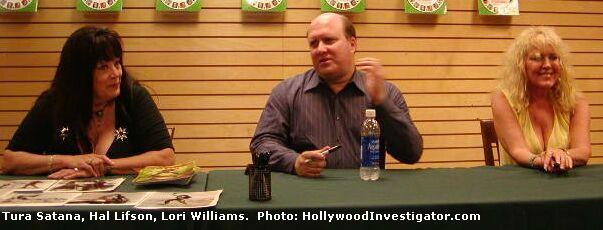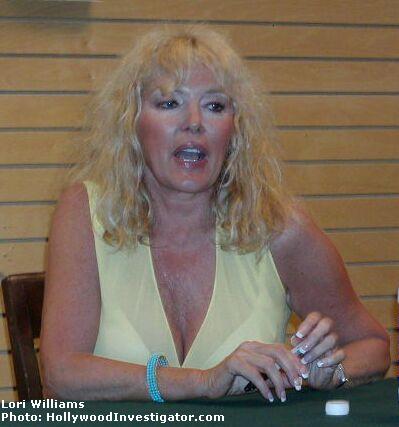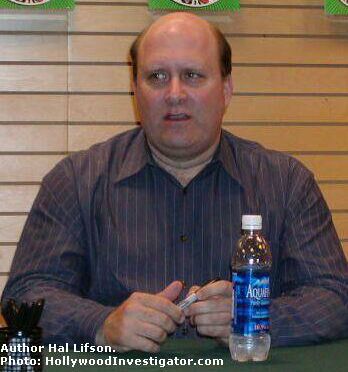TURA SATANA, LORI WILLIAMS RECALL FASTER PUSSYCAT,
KILL! KILL!
by Hank Willow, staff reporter.
[August 28, 2003]
 [HollywoodInvestigator.com]
Actresses Tura Satana and Lori Williams reminisced over their 1966 cult
movie classic, Faster
Pussycat, Kill Kill, at the Santa Monica Barnes & Noble bookstore
on June 27, 2003 -- and the Hollywood Investigator was there! [HollywoodInvestigator.com]
Actresses Tura Satana and Lori Williams reminisced over their 1966 cult
movie classic, Faster
Pussycat, Kill Kill, at the Santa Monica Barnes & Noble bookstore
on June 27, 2003 -- and the Hollywood Investigator was there!
Joining them was author/publicist
Hal Lifson, promoting his book, Hal
Lifson's 1966! A Personal View of the Coolest Year in Pop Culture History (Intro by Adam West & Nancy Sinatra), who said that Faster
Pussycat was "one of the forerunners to the feminist movement in filmmaking
and Russ Meyer's best movie, with a real political message, as well as
an interesting story."
But shockingly,
despite Faster
Pussycat's eventual cult success, Tura Satana almost turned down her
chance to audition -- because of director Russ Meyer's soft porn reputation!
Only after Satana's agent reassured her that the film "wasn't like that"
did Satana go see Meyer.
Once at
the audition, Satana said, "Russ asked me, 'How would you play the lead
in this script?' So I read a couple of scenes and I said, I could
play her two ways. I could play her very soft and feminine, or I
could play her as a very ballsy woman." Russ asked her to read it
both ways -- and picked the ballsy broad.
 Satana said everyone had
fun shooting Faster
Pussycat, despite its desert location. "We did everything together. We moved scenery, we moved props, people, bodies, rattlesnakes, tarantulas. We had a pet tarantula that loved to crawl up into my hair. Satana said everyone had
fun shooting Faster
Pussycat, despite its desert location. "We did everything together. We moved scenery, we moved props, people, bodies, rattlesnakes, tarantulas. We had a pet tarantula that loved to crawl up into my hair.
"Of course, it was like 110
in the shade, and being in solid black tends to get a little warm.
I wound up with a hell of a sunburn. But it wasn't as bad as some
of the other girls."
"Black
has always been my color," she added.
Faster
Pussycat, shot over eight weeks in 1965, was released in 1966. Lifson commented that eight weeks is a "lot longer than a lot of B movies
at the time," adding that it "really should be seen on the big screen."
"Everything
was done with stationary cameras," said Satana. "No dollies, no moving,
no handheld cameras."
"That's
unusual for a movie shot on location," Lifson quipped.

Faster
Pussycat is famous for its femme fights, predating Lara
Croft, Buffy
the Vampire Slayer, and Emma
Peel.
"I did
all my own fight scenes," said Satana. "I choreographed all the fights. I had to literally carry some of the guys through the fight scenes because
they were afraid of getting hurt. Especially the first guy that I
broke his neck [in the film]. He was scaredest of all. He was
the biggest chicken when he had the tarantula! But nobody ever got
hurt."
Born in
Japan, Satana trained early in martial arts. "I started studying
marital arts when I was about eight years old," she said. "I was
studying aikido, which is very good for women, because they don't have
to worry about ruining their hands. A combination of karate and aikido
and judo. It's basically using your opponent, and his strengths and
his weaknesses."
Women
also benefit from aikido's emphasis on self-defense. "The first thing
you're taught in martial arts is to be defensive. Unless you study
for maybe ten, fifteen years, you won't get into any offense."
After Faster
Pussycat, Satana continued her involvement in the martial arts community. "I knew Bruce Lee. I knew Chuck Norris."
Apart
from marital arts, Satana also studied exotic dancing. "I started
at about fifteen years old." There were also strict rules back then. "We never walked around backstage without being fully clothed. You
never ever swore backstage. And you never fooled around with anybody
else's boyfriend or husband."
Several
years before Faster
Pussycat, Satana put her exotic dancing to use in Who's
Been Sleeping in My Bed? (1963), by teaching Carol Burnett how to do
a striptease. "I got paid for both acting and choreography," said
Satana.
 Lori Williams
came to Faster
Pussycat through a cattle call -- but nearly failed to get cast! "Russ wasn't going to hire me because he didn't think I was buxom enough,"
said Williams. "But then Russ decided to work it out in wardrobe." Lori Williams
came to Faster
Pussycat through a cattle call -- but nearly failed to get cast! "Russ wasn't going to hire me because he didn't think I was buxom enough,"
said Williams. "But then Russ decided to work it out in wardrobe."
Despite attending the cattle
call, Williams too had reservations about working for a soft porn director. "It kind of scared me at the time, because I was known for popcorn and
fluff beach party movies. But it turned out to be one of the better
experiences, because Russ was such a professional. He was a good
guy. He ran a tight ship."
The script's car chases also
unnerved Williams. "I didn't know how to drive. I learned on
the film how to drive."
Unlike
the older and wiser Satana, Williams was inexperienced in many ways. "The first shoot was at night, in this bar. I was like nineteen,
and I was clueless. I didn't drink or anything. I didn't know
what was going on. So they said, 'Jump up on the bar and we're gonna
put some music on and this is the opening of the movie. Just get
up there and dance.' "

* Pussycat Politics
"Faster
Pussycat showed that women didn't have to be the weaker sex," said
Satana. "We didn't have to pussyfoot around guys. Someone got
in our way, we just knocked them out. Thelma
and Louise was just a takeoff on Faster
Pussycat. Basically said the same thing, that women didn't have
to be the weaker sex."
Lifson
said the film "stands apart from the Russ Meyer library because of its
[feminist] sociological message. I always wondered why some of his
later films he didn't really try to do that."
"He went
back to his old [porn] motifs," said Satana. "The one thing about
this film he was trying to prove, his morals were that good always winds
up beating bad. That's why we had to die in the end, because we were
bad girls."
"And sadly,"
quipped Lifson, "the trend of women wearing white go-go boots in the desert
didn't last."
"When
I see that movie now," said Williams, "I see all the characters as comic
book come to life. I would have lines laying atop the Porsche. Nobody does that. I fought Russ on that. I had studied serious
acting. Why don't I just talk? He said, 'You don't understand,
this is a cartoon, this is a camp, exaggerate it, be corny.' And he was right."
In the
1970s, Williams went on to a career guest starring on television, including
"about four" episodes of Charlie's
Angels. She sees the recent film version as an extension of Faster
Pussycat's comic book aesthetics and feminist message. "It's
escapist and fun and still has that message. Demi Moore is a statement
in that she's older than the other gals, and hanging the toughest of them
all."
Williams
likes the message that older women are still tough and sexy -- because
she quit acting due to ageism!
Williams
was still getting invited to "T&A calls" in the late 1970s. "I
was getting very uncomfortable. I was like thirty-two, and the oldest
person at the interview was eighteen. This was for a movie, and right
before I came in, I heard 'Now the next one coming in is Lori Williams. She's an oldie but a goodie.' I heard that at age thirty-two. I walked in with a bikini on, because it was a bikini call, and my face
was hot."
After
that, Williams quit acting for a new career in casting. "I got into
casting through Universal, because I did a Baretta. The casting director was looking for someone to work with. I did
that for a while. That was fun. I did well at it. But
now that I'm older, I'm going back to acting."
"Charlie's
Angels was a takeoff on The
Doll Squad," said Satana, who appeared in the 1973 Ted V. Mikels film.
"I took Aaron Spelling to the screening. I'd recommended Francine
York [who played Sabrina Kincaid in the film] for the part of Sabrina. I was one of her sidekicks [in The
Doll Squad]. Judy McConnell was there, and Leigh Christian, and
a couple of other girls. And after he saw the screening, it was I
think three months later, there was Charlie's
Angels. He didn't even change the original name for the first
girl. It was Sabrina."
The recent
mega-success of Lara
Croft and the Charlie's
Angels movie indicates that Faster
Pussycat's kick-ass broads are here to stay. "I think that door's
been kicked way open," said Williams. "I don't think it's ever going
to be closed again. I think that's so over."
Satana
added that it'd better be, or she'll kick it back open. "It's much
better than it was. Women have finally come into their own. Before they were housewives. They were weak, or they were somebody's
girlfriend running away. Somebody hiding, somebody crying, somebody
weeping. But now it's a whole new ballgame. Women are starting
to do something else beside stand in the kitchen and cook dinner, or look
pretty, or be an ornament on the beach. You can still look pretty
and kick ass."
Faster
Pussycat's influence also extends to a band of the same name. "Russ Meyer was originally connected with the band," said Satana. "And whenever they played, they showed the film behind them, and it seems
to bring in the audience a little bit more. Russ allowed them to
use the name."
* Lifson's 1966
But although
the two tough broads dominated the panel conversation, the centerpiece
of the Barnes & Noble gathering was moderator Lifson's new book, Hal
Lifson's 1966! A Personal View of the Coolest Year in Pop Culture History (the year Faster
Pussycat was released).
The Hollywood
Investigator asked Lifson why devote a book to 1966, as opposed
to some other year?
 "I didn't mean for this
book to make a claim that this was the best year of the Sixties," Lifson
replied. "What it's really supposed to show you is that, for me,
it was my favorite year of the Sixties. That's why I called the book Hal
Lifson's 1966, as opposed to just 1966, where people might assume it's
more of an encyclopedia or a textbook about the one year. "I didn't mean for this
book to make a claim that this was the best year of the Sixties," Lifson
replied. "What it's really supposed to show you is that, for me,
it was my favorite year of the Sixties. That's why I called the book Hal
Lifson's 1966, as opposed to just 1966, where people might assume it's
more of an encyclopedia or a textbook about the one year.
"But to really answer your
question, I feel that this one 12-month period best symbolizes the Sixties
in terms of pop culture. I'm not including in this book the news
events of the year. I wouldn't have chosen 1966 for the most significant
year in terms of sociological or political events."
The Investigator then asked Lifson if, in terms of culture, he sees a big difference between
the early Sixties and late Sixties -- and if he thinks 1966 represents
a melding of the two?
"That's an interesting
way to phrase it," said Lifson. "I think that '66 was a unique year
because it was the last year where a lot of innocence from the early Sixties
was still present, but also the first year that the psychedelic images,
psychedelic music, the more subculture-oriented things from the pop world,
began to appear in the mainstream. It was a transitional year. If you look at TV or magazines from '66, you do see that. But I have
to say, '67 had a lot of great stuff. A lot of the years of the Sixties. I might do a few other books. I'm hoping to do 1969 as my next one."
Lifson
became a publicist because he wanted to meet and work with his childhood
idols. Today, he represents many of the people he writes about --
including Adam West and Nancy Sinatra, who wrote introductions for Lifson's
book! Lifson found his life's calling through an entry level job
in advertising.
"I would go through the Rolodexes, and get the contact
numbers for some of the people at the agencies I worked at. As I
got to know them better, I would offer to do PR for them, separate from
what the agency was doing, which was to try to get them work. I would
try to get them publicity or little articles, and I was successful. I started with Adam West. He was my first client."
What's
the secret to being a successful publicist? "You you have to have
an angle [for the publication]," said Lifson. "Something that goes
with the client or the story, over and above your wanting them to write
about it. So it forces you to be a writer, to be creative."

* Future for Pussycats
While Lifson
is working on his next book, Satana and Williams are preparing for their
next film, to be shot in fall: Please Sign It, Love! It will star
several Russ Meyer alumni, including Cynthia
Myers, Teresa Ganzel, and
a cameo by Mamie van Doren.
 Satana is also "appearing"
in a new comic book, Tura Satana. Satana is also "appearing"
in a new comic book, Tura Satana.
"For the first time I'm playing
one of the good guys," she said. "This is the first issue, a very
limited run issue. If it works out, there might be others to follow. Mike Hoffman of New Mexico did all the artwork.
Satana
recently completed her autobiography. "It's being edited right now,"
she said. And there's a filmed biography in development. "There's
a producer that wants to do my life story because, he says, not only do
I benefit the oriental women, but women in general." Satana is currently
assisting the producer in casting a young Satana. "I've been looking
at a few girls."
While
preparing to revive her acting career, Williams also has a day job. "I work in real estate on the Westside. Santa Monica, Brentwood,
Pacific Palisades. I've been doing that for a while."

* Elvis Presley
In their
amazing careers, both Satana and Williams knew Elvis Presley, and each
shared their Elvis encounters with Lifson and the Barnes & Noble audience.
"I was
sixteen years old," said Satana of her first encounter with Elvis. "I first met him by accident in Biloxi, Mississippi. But I really
got to know him in Chicago, 1955, '56. I was working in a theater. I was dancing, and I used a lot of acrobatics in my routine. He came
backstage with the theater owner and asked, 'How do you do that?' I told him my routine was based on martial arts. He asked if I could
teach him. Martial arts is not only a disciplinary form of art, but
it teaches you control. And he said, "Well, you got control.' I showed him how to do the shimmy, and some other stuff. We started
dating."
Satana
added that "very few people know" of her affair with Elvis -- but that
additional information will appear in her soon-to-be-published autobiography!
Williams
related an incident that occurred while she worked on Elvis's film, Kissin'
Cousins. "We were up in Big Bear. I was hired as a dancer. Elvis had a thing where he had to have people he felt comfortable with. He always said that's why we were in the troupe as a dancer. He didn't
like anyone outside moving in. He had rented a whole cabin up in
Big Bear. I was intimidated, but not by much, because he was so far
out of the realm of things I didn't really go there anyway."
One day
Williams attended a gathering at Elvis's cabin. "I went to the bar
for a glass of milk. He comes up right behind me and says,
'Are you getting a glass of milk?' I said yes. He said,
'That's what I'm having.' It was a corny, simple thing. We sat on the sofa, drinking our milk. When people were leaving,
he said, 'I don't want you to get a bad reputation. I don't want
anybody to say anything bad to you, so I'm gonna have Richard drive you
down to your log cabin. You go with everybody else, because I want
to make sure you don't have a bad reputation.' "
Williams
said that Elvis told her that he didn't do drugs, and she didn't know anything
about his alleged drug habit. "He was a really nice guy, and a complete
gentleman. Gave me a lot of work."
Hank Willow is a Los Angeles based tabloid reporter who has extensively investigated Hollywood scams against actors. Read more about his journalism in Hollywood Witches. |
ELVIS FANS:
Read the shocking story of Elvis Presley's stolen
pipes! |
Copyright 2003 by HollywoodInvestigator.com

|
